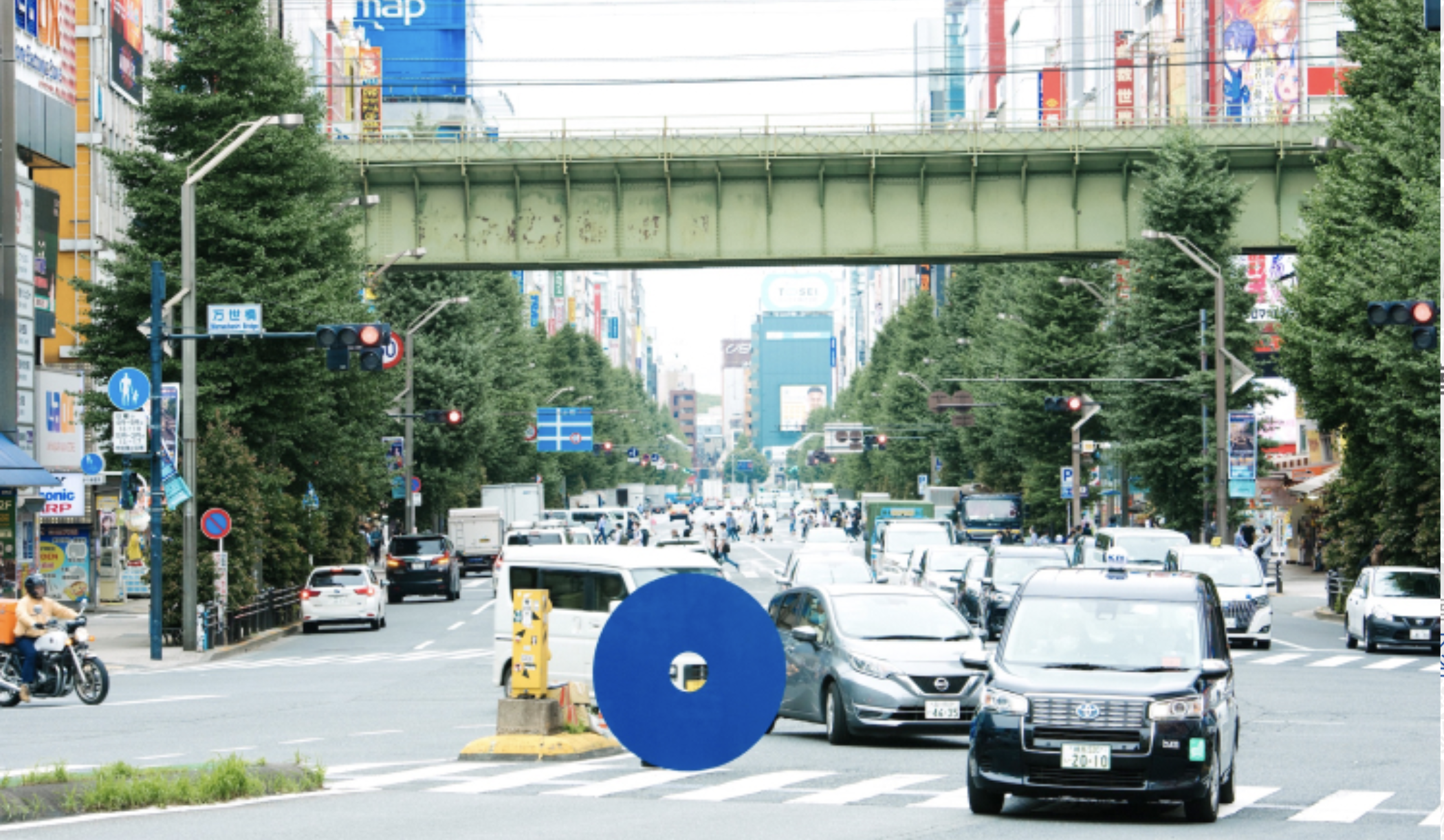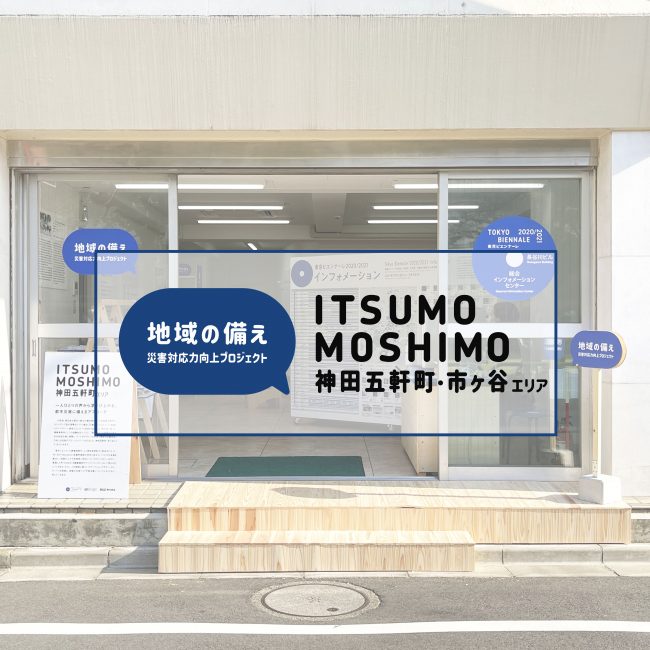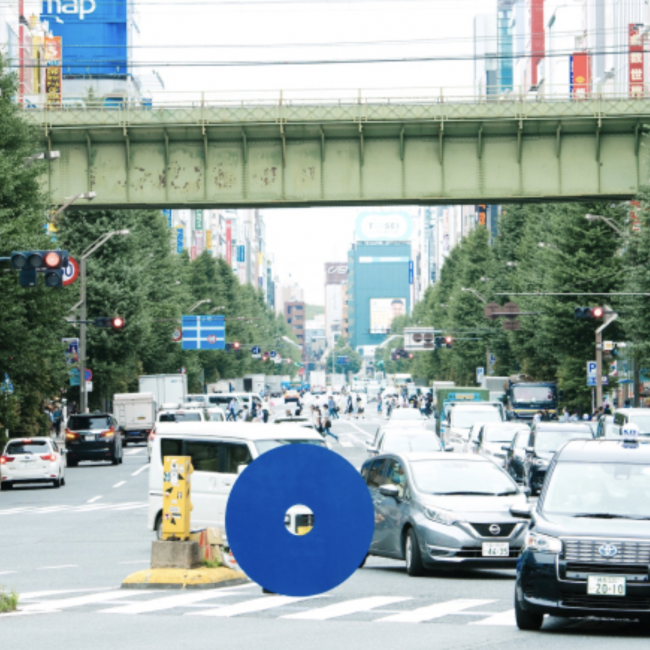Tokyo Biennale
#01
都市とアート、
その関係性の設計
Tokyo Biennale
× Ondesign
#01
Urbanism, Art,
and Designing the in-between.
オンデザインは、今夏開催の芸術祭『東京ビエンナーレ2020/2021』において、約70箇所におよぶ展示スペースの会場計画をプロデュースしています。この連載シリーズでは、ふだん建築という専門領域に身を置く私たちが「芸術祭」に関わることに、どのような意義があるのか。そして、アートという領域に踏み込むことによって、どのような化学反応が起こりうるのか。現場の実体験をもとに検証し、レポートしていきます。
Ondesign has played a leading role as venue conductors in the International Art Festival Tokyo Biennale 2020/2021. What does it mean for an architect to be involved in an art festival? To what extent can chemical reactions be triggered when an architect takes a leap into the art field?
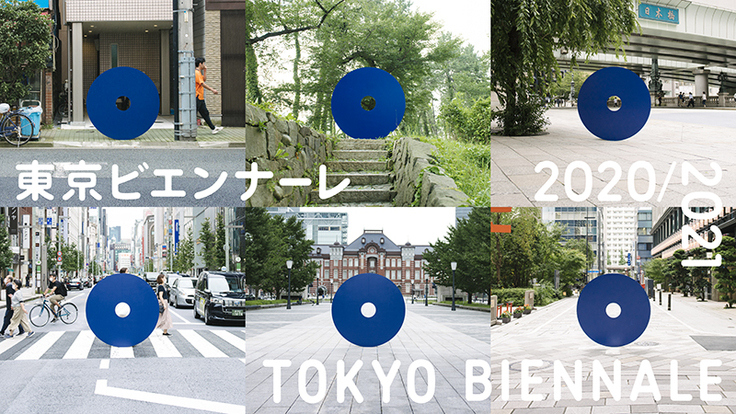
アートと社会をつなぐ、
民間の市民委員会が企画運営する芸術祭
An art festival, driven by a private sector, connects art to society.
東京ビエンナーレは、2021年夏に東京北東部(主に千代田区、文京区、台東区、中央区)を中心に開催される国際芸術祭。本来は去年の夏に開催予定だったが、コロナの影響で一年延期となり、ようやく今年7月10日~9月5日をコア期間として開催される運びとなった。
「芸術祭」と言えば、これまで国内(瀬戸内芸術祭/横浜トリエンナーレ/あいちトリエンナーレ/大地の芸術祭など)や、海外(ベネチアビエンナーレ/ベルリンビエンナーレなど)で多数行われてきたが、東京での開催は今回が実質はじめてのこと。大都市で行う芸術祭として世界から注目されている。
キュレーター・長谷川裕子によると、ビエンナーレやトリエンナーレなどの芸術祭は、「都市を巻き込んで行われる大規模国際展であるため、社会的な影響が大きいキュレートリアルの行為の一つである。」(『キュレーション 知と感性を揺さぶる力』/集英社新書刊)という。芸術祭は往々にして「場の活性化」を主な目的としてかかげるがゆえに、ほとんどの芸術祭が行政主体であり、アートそのものが発するステイトメントよりも展覧会を通しての教育、啓発、経済効果が評価される傾向にある。しかし、東京ビエンナーレは、完全に民間主体の芸術祭。2018年に市民委員会を発足させ、これまで地道な準備を進めてきた。約60組を超えるアートプロジェクトが「地場から発する」ようにあちこちで自発的に組織されており、コロナ禍のなかでも制作活動を続けている。
Tokyo Biennale 2020/2021 is an international art festival taking place in summer 2021. While being initially planned to take off the summer of 2020 and postponed for a year due to the unprecedented outbreak of the pandemic, the Tokyo Biennale team has worked diligently step by step through the hectic extra year, to make it happen at last.
Many art festivals exist, both within the country and overseas, whereas it is the first official biennale to be held in Tokyo. An art festival to take place in the huge metropolis has been spotlighted especially for its venue.
“An art festival is the ultimate form of curatorial demeanor to create social impact, as it essentially involves the city as a whole” as quoted by curator Yuko Hasegawa. As is often the case, art festivals are sponsored by public sectors aiming for revitalizations of the areas, and therefore the evaluations of these festivals tend to be based on how much impact they have on education, enlightenment, and economic growth, rather than the statements and the messages individual artworks convey. Tokyo Biennale, on the other hand, started off by collection members of the Tokyo Biennale Citizens Committee, and has been ever since operated completely by a non-profit, private organization. All across Tokyo, more than 60 art projects are initiatively constructed, as if emerging from the land and growing on their own.

東京ビエンナーレ2020/2021 メインビジュアル アートディレクション&デザイン:Asyl(佐藤直樹+菊地昌隆)
都市の日常の風景に、
非日常を埋め込む
Implanting extraordinary sceneries into ordinariness.
そもそも東京ビエンナーレが興味深いのは、「日常的に使われている建築や場所へアートがインストールされること」であり、突如出現する「非日常性」の違和感が、見なれている何気ない都市の風景を〈見なれぬ景色〉と変貌させ、今まで気が付かなかった価値を再発見するきっかけをつくり出すことにある。この大きなビジョンを実現するためには、作品の一つひとつの内容、クオリティー、メッセージ性が当然重要ではあるが、それと同等、あるいはそれ以上に、〈作品会場〉を選定するプロセス、すなわち〈場所〉が発するメッセージそのもを読み取るという行為と、作品会場同士をつなぐ〈間〉の経験をデザインするプロセスが不可欠。東京という大都市は、ここ数十年で大きく、また急激に姿を変えてきたが、古くからの痕跡もまだまだ残っており、多様な空間軸と時間軸の中をさまよっている。東京の、どの場所をどのようにハックし、作品を埋め込み、点と点を結ぶか。この問いに対する答えが、芸術祭のゲームチェンジャーとなる。
オンデザインは、アートと都市のつなぎ方をデザインする会場コーディネーターとして、クリティカルな役割を担っている。アートと都市の「関係性」を丁寧に設計することは、その両方が同時にアップデートされることにもつながる。そして、アートという非日常の要素を日常の何気ない風景に埋め込むことにより、東京という都市空間の「経験」と「体験」を一変させる。「東京ビエンナーレ」というフィルターを通して見る東京は「美術館」そのものであり、訪れる人は移動しながらアートを鑑賞し、アートとの新しい関係性、その向き合い方を体験することになる。
各会場の具体的な計画内容については、一言では説明できない。会場計画は、サイン計画、新規会場開拓、ルート計画、作品インストールなど、複数のプロジェクトで構成されているからだ。オンデザインは、これらのプロジェクトを通じて、それぞれ異なるアプローチを行い、都市とアートのつなぎ方を試みている。今後の連載では、それぞれのプロジェクトで担う、この「つなぎ役」とは何か、その内容を具体的に紹介していく。
In Tokyo Biennale, the art projects are spontaneously installed into ordinary buildings and spaces which are otherwise routinely used on a daily basis. The significance of this art festival lies in the fact that in this twitch of implanting something out of the ordinary into the sceneries people confront everyday, and often taken for granted, creates this inner sense of an intimate strangeness within the people, giving them an opportunity to rethink the values of daily routines, which a lot of people are otherwise unconscious about. In order to realize this vision, perhaps as important as, or even more important than the qualities of the artworks and the messages they convey, is to understand on a fundamental level, and empathize with the messages the venues themselves convey, as well as to design the experience of moving from one venue to another. Even though Tokyo has experienced drastic changes in the past 40 to 50 years, small but crucial traces of history still remain scattered throughout the city, identifying Tokyo as the complicated junction of countless spatial and chronological axes. Where in Tokyo do we hack to create an art point, and how do we do it? How do we install extraordinary sceneries and how do we connect the dots? Answering these questions are the ultimate game changers of a truly impactful art festival.
As venue conductors of the art festival designing the relationship between the city and art, Ondesign is responsible for this very role; to find solutions to these questions. Designing this “in-between” thoroughly and carefully brings about updating simultaneously the perceptions people have towards both city and art. Embedding an extraordinary element into an ordinary scenery changes the way people experience Tokyo. Tokyo as seen through the lens of “Tokyo Biennale” is a museum of movement by definition, and people discover, on a personal level, new ways of confronting art and developing the relationship.
What we do as venue conductors is impossible to dictate with limited words. Our job as venue conductors consists of multiple projects such as signage planning, venue excavations, route planning, and installing artworks on site. Through these projects we take on different approaches to achieve the goal of redefining the relationship between city and art. Throughout this Beyond Architecture article series, we aim to introduce each of these approaches in detail.
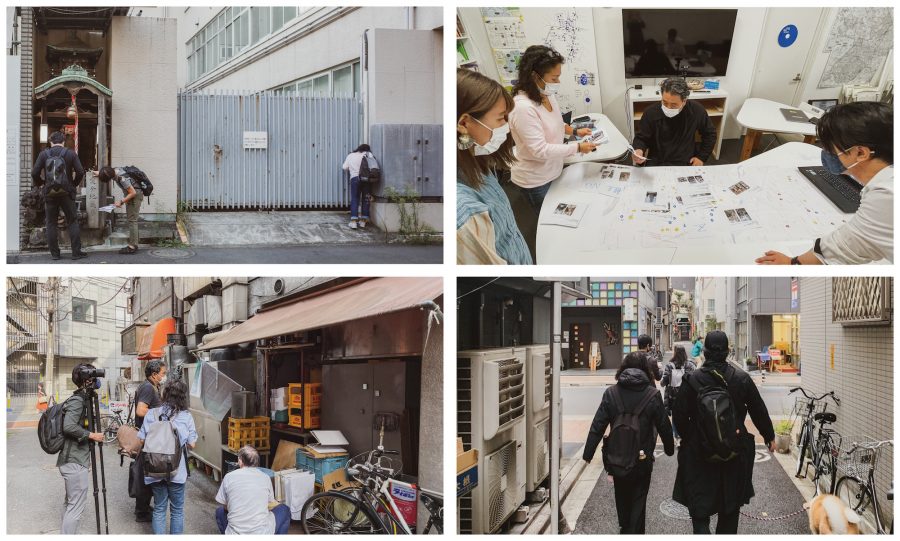
タイトル:東京に潜む、粋な物件をあぶりだす「東京Z学」
Project “Tokyo Z-ology” Exposing the desperate but romantic buildings that nest deep within Tokyo (https://tb2020.jp/project/tokyo_z/)
(作品の展示会場となりうる場所を見つけ出すために発足した、新規会場開拓チーム。リアルなまちを練り歩き、誰にも気づかれないけれども、東京の特徴と歴史を浮き彫りにするディープな物件を探す。/The “Tokyo Z-ology” team was established within Ondesign’s Tokyo Biennale Venue Conducting team to find potential venues in Tokyo. Walking around the actual city, we shed light on places that modestly highlight the characteristics and history of Tokyo, and which otherwise would never be noticed. )
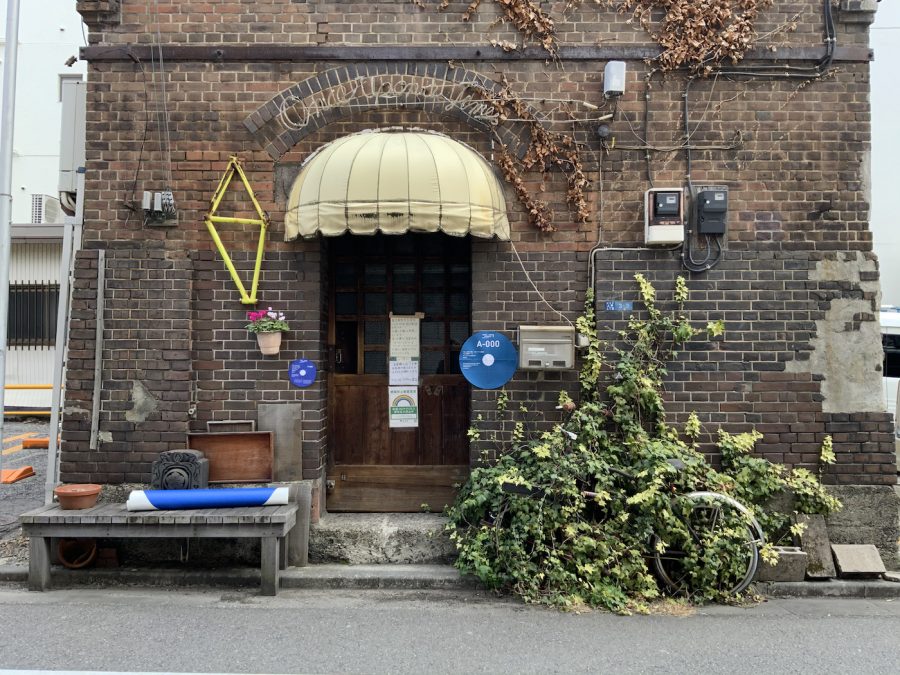
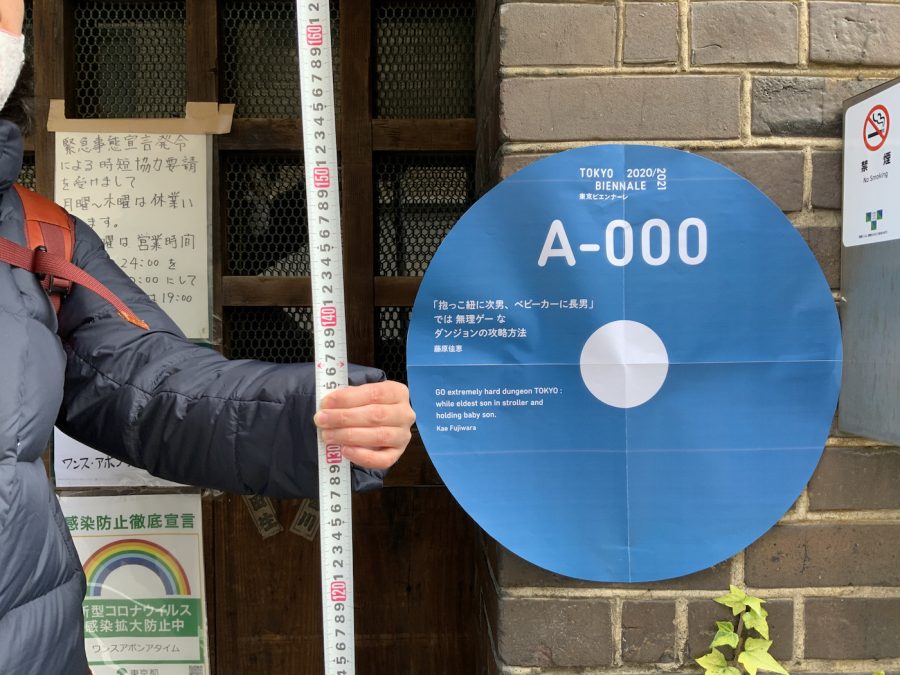
タイトル:サインの見え方検討の様子
Investigating how Tokyo Biennale logo signs appear in the city
(東京に「見なれぬ景色」をいかに演出するかは、アート作品そのものだけでは事足りず、オンデザインが主導するサイン計画もクリティカルな役割を担っている。/Ondesign is also responsible for the signage planning of the art festival, which also plays a critical role in bringing about “extraordinariness” into the urban context.)
形のないものを
設計する
Designing elements without physicality
会場計画とは、一般的な建築設計業務とは本質的に異なり、私たちがデザインし、世の中に形として残る物理的なものは、何ひとつとして存在しない。言語化するのが難しく、それこそが本質であると言っても過言ではない。
建築家が目指す目標は、いうまでもなく「建築」をつくることである。しかしそれには、往々にして長いプロセスがともなう。一方、評価の対象となるのは、その「長いプロセス」の最終成果物である「建築」単体だ。オンデザインは10年ほど前から、〈プロセスの設計〉や〈参加型デザイン〉などによる集合知のデザイン、または建築家自らがプレイヤーとなるような〈実践型の設計〉などに積極的に取り組んできた。そして今、「設計」という概念は大きく変貌を遂げてきているという文脈から、今回の設計対象を「形のないもの」とし、そのつかみどころのないモノ・コトを「どのように都市空間における空間体験へと昇華させるか」を計画のテーマとした。
建築設計においては、評価対象として建築単体に着目するのは当然だ。なぜならそれが客観的対象物であり、目に見えるものであり、評価軸が明確であるからだ。一方、はたしてその建築には作家性があるか、つまり有名な建築家ないし、設計事務所の作品であるかどうか。また、インスタグラムで他より映えるようなフォトジェニックさがあるか。そうした社会的、歴史的文脈の中で語られる目に見えない価値による評価軸もまた明確である。
では、最終成果物として建築という「物体」をつくりあげないというのであれば、いったい建築家の職能が「どこで発揮され、埋め込まれるのか」。物体として現れないということは、私たちが「建築家」として本来であれば踏み入めないようなフィールドに挑戦し、プロセスそのものに意義と本質を見出し、数多くの検討と試行錯誤を繰り返し行った結果導かれた、ひとつの「現象」に近いものかもしれない。
今回、東京ビエンナーレ会場計画を担う私たちオンデザインのチームメンバー一人ひとりが、それぞれにとっての「建築家」を再定義し、自らの職能を超えるために、どう挑んでいるか、この連載を通じて提示していきたい。
What we are achieving as venue conductors is substantially different from what we would generally define as a “normal” job of an architect, in the sense that what we’re designing has no specific shape. Saying what we are actually doing is difficult to explain in words would be an understatement, and this is perhaps where the essence of this project truly lies.
Without question, architects, by definition, make architecture, and more so, that is our goal. Many architects would agree that creating architecture is often, and fundamentally, a series of processes that consume unbearable amounts of time: it is rarely the case that every single hour one spends working on the project leads directly to the accomplishment. On the other hand, it is more likely to be the case that what we are evaluated by is the actual architecture itself, built as the final outcome of the endless process. Over the past 10 years, Ondesign has been facing challenges to revolutionize the concept of “design” and to expand the definition. Designing not just the outcome but the process itself, and interactively involving clients and users in our design process are examples of new approaches to design collectively. We also take the initiative to become active players in the aftermath of the projects we design, instead of just passively observing as an outsider. Our mission as venue conductors of Tokyo Biennale finds its place in this very context of redefining design, designating “elements without any physical existence” as design subject, putting these nameless elements which would otherwise seem like “catching air,” and outputting it as spatial experiences in Tokyo’s the rich urban context.
It is inevitable that architecture is evaluated by the architecture alone: one can actually see the object which he or she is to evaluate, and the standards cannot be clearer. Is the architecture of any artistic value, in other words, is it designed by a worldly known architect? Is the architecture photogenic enough to be posted on one’s instagram and get satisfying amounts of likes? Does it have any historical or cultural significance? These are some of the questions that arise when our focus is on mere existing, visible objects.
Because we are not building actual architecture through this project, it is difficult to say how we are contributing as architects: one might even argue that we are forfeiting the professional role. However, the unavoidable fact that the final outcome of the long processes does not conclude itself as a physical existence but a sheer phenomenon derived by countless trial and errors, is evidence that we are taking a giant leap, and bringing in the inner architects into an outside field, finding substantial qualities in the process itself.
We aim for this Beyond Architecture articles series to be a manifestation to show the underlying philosophy and our approach, with every one of us having our own definition of what it means to be an architect, both as individuals and as partners.
次回は、芸術祭の「サイン計画」を通じて、アートと都市の関係性をアップデートするというミッションに、私たちがどのように挑戦してきたかを検証&考察します。
data
東京ビエンナーレ2020/2021公式ウェブサイト https://tb2020.jp/
災害応力向上プロジェクト https://tb2020.jp/project/projects-to-improve-disaster-response/
東京Z学 https://tb2020.jp/project/tokyo_z/
インスタグラム https://www.instagram.com/tokyobiennale/?hl=ja
project members
一色ヒロタカ(会場計画ディレクター)/村田百合/宮野健士郎/渡邉莉奈/小澤成美/内藤あさひ/高橋慧一/吉村有史
執筆者プロフィール
村田百合 yuri murata
1992年横浜生まれ。2015年東京大学工学部建築学科卒業。2018年同大学院修了。同年よりオンデザイン。

